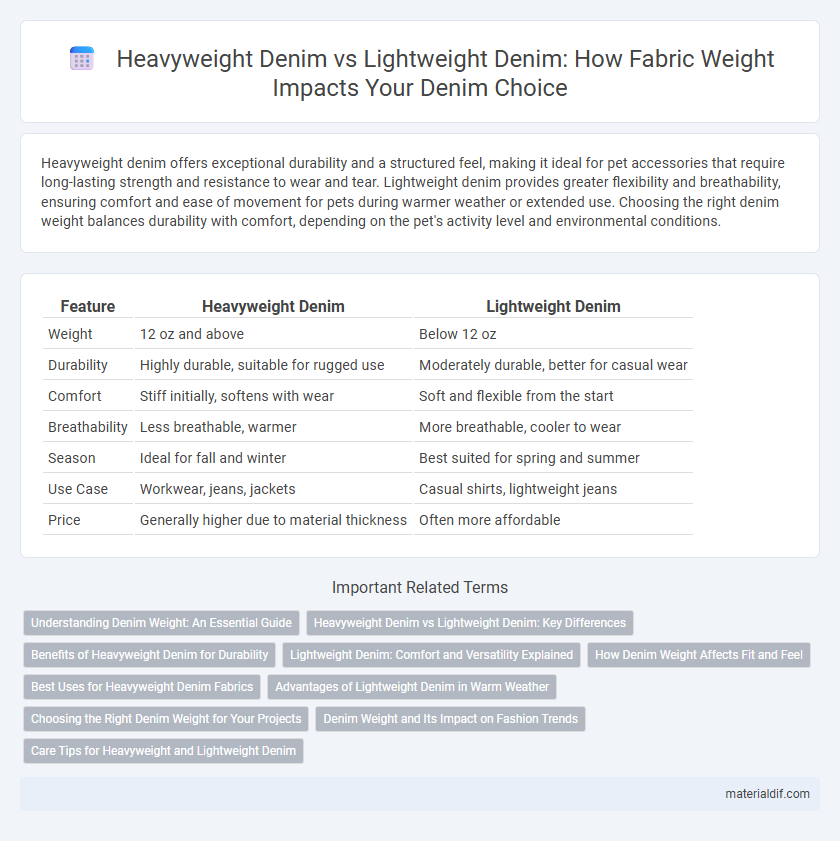Heavyweight denim offers exceptional durability and a structured feel, making it ideal for pet accessories that require long-lasting strength and resistance to wear and tear. Lightweight denim provides greater flexibility and breathability, ensuring comfort and ease of movement for pets during warmer weather or extended use. Choosing the right denim weight balances durability with comfort, depending on the pet's activity level and environmental conditions.
Table of Comparison
| Feature | Heavyweight Denim | Lightweight Denim |
|---|---|---|
| Weight | 12 oz and above | Below 12 oz |
| Durability | Highly durable, suitable for rugged use | Moderately durable, better for casual wear |
| Comfort | Stiff initially, softens with wear | Soft and flexible from the start |
| Breathability | Less breathable, warmer | More breathable, cooler to wear |
| Season | Ideal for fall and winter | Best suited for spring and summer |
| Use Case | Workwear, jeans, jackets | Casual shirts, lightweight jeans |
| Price | Generally higher due to material thickness | Often more affordable |
Understanding Denim Weight: An Essential Guide
Denim weight is measured in ounces per square yard, with heavyweight denim typically ranging from 12 to 16 ounces and lightweight denim falling between 5 to 10 ounces. Heavyweight denim offers increased durability and structure, making it ideal for rugged wear and long-lasting jeans, while lightweight denim provides greater comfort and breathability, suited for warmer climates and casual styles. Understanding denim weight helps consumers choose fabric that balances strength, flexibility, and seasonal suitability for optimal wear experience.
Heavyweight Denim vs Lightweight Denim: Key Differences
Heavyweight denim typically ranges from 12 to 16 ounces per square yard, providing increased durability and a rigid structure ideal for workwear and long-lasting jeans, whereas lightweight denim usually measures under 12 ounces, offering greater breathability and comfort suited for warmer climates and casual wear. The denser weave of heavyweight denim supports enhanced resistance to abrasion and fading, making it preferred for rugged activities, while lightweight denim's softer feel allows for easier movement and quicker drying. Choosing between heavyweight and lightweight denim depends on the balance between durability needs and comfort preferences, influenced heavily by wear environment and garment function.
Benefits of Heavyweight Denim for Durability
Heavyweight denim, typically ranging from 12 to 16 ounces per square yard, offers superior durability compared to lightweight denim. Its dense weave and thicker fabric structure resist tears, abrasions, and fading, making it ideal for workwear and long-lasting jeans. The increased durability of heavyweight denim ensures garments maintain their shape and appearance through extended wear and multiple washes.
Lightweight Denim: Comfort and Versatility Explained
Lightweight denim typically weighs less than 10 ounces per square yard, offering enhanced breathability and comfort for everyday wear. Its thinner fabric allows for greater flexibility and ease of movement, making it ideal for warmer climates and layering in transitional seasons. Versatile in style, lightweight denim easily adapts to casual looks and can be dressed up or down without sacrificing durability.
How Denim Weight Affects Fit and Feel
Denim weight significantly impacts both fit and feel, with heavyweight denim typically ranging from 12 to 16 ounces, offering a stiffer, more durable fabric that molds to the body over time for a personalized fit. Lightweight denim, usually between 5 to 10 ounces, provides a softer, more breathable feel, ideal for warmer climates and relaxed fits that allow greater mobility. Understanding the weight of denim helps consumers choose between rigid durability and comfort, influencing the garment's drape, break-in period, and overall wearability.
Best Uses for Heavyweight Denim Fabrics
Heavyweight denim, typically ranging from 12 to 16 ounces per square yard, is ideal for durable workwear, rugged outdoor clothing, and high-quality jeans that require long-lasting wear. Its dense weave and substantial thickness provide excellent protection and resistance to abrasion, making it suitable for labor-intensive activities and colder climates. Designers and manufacturers favor heavyweight denim for products demanding structural integrity and enhanced durability over extended periods.
Advantages of Lightweight Denim in Warm Weather
Lightweight denim, typically ranging from 5 to 9 ounces per square yard, offers superior breathability and comfort in warm weather compared to heavyweight denim that exceeds 12 ounces. Its thinner fabric reduces heat retention and enhances moisture evaporation, making it ideal for hot and humid climates. The flexibility and softness of lightweight denim also provide ease of movement and prevent overheating during prolonged outdoor activities.
Choosing the Right Denim Weight for Your Projects
Selecting the right denim weight is crucial for achieving the desired durability and comfort in your projects. Heavyweight denim, typically ranging from 12 to 16 ounces per square yard, offers superior strength and longevity, making it ideal for rugged workwear and jackets. Lightweight denim, usually between 5 to 10 ounces, provides greater breathability and flexibility, perfect for casual wear and warmer climates.
Denim Weight and Its Impact on Fashion Trends
Denim weight, measured in ounces per square yard, significantly influences fashion trends by dictating the fabric's durability and comfort; heavyweight denim (12-16 oz) is favored for rugged, long-lasting garments like jeans and jackets, while lightweight denim (5-10 oz) suits breathable, casual wear ideal for warm climates. The rise of heavy denim aligns with a demand for heritage fashion and streetwear aesthetics, emphasizing toughness and vintage appeal. Conversely, lightweight denim drives trends in fast fashion and athleisure, promoting ease of movement and seasonal versatility.
Care Tips for Heavyweight and Lightweight Denim
Heavyweight denim, typically ranging from 12 to 16 ounces per square yard, requires gentle washing in cold water and air drying to preserve fabric integrity and prevent shrinkage. Lightweight denim, around 8 to 12 ounces, benefits from more frequent washing to maintain softness, ideally using mild detergents and avoiding high heat in dryers. Both denim types should be turned inside out to reduce fading and prolong garment lifespan.
Weight (Heavyweight Denim vs Lightweight Denim) Infographic

 materialdif.com
materialdif.com